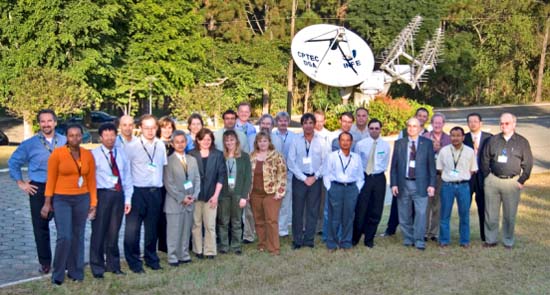The US Earth's Surface Observing Satellite, Landsat Data Continuity Mission (LDCM)

The Landsat Technical Working Group #16 was held in Brazil from May 14 - 18, 2007 with the participation of eleven countries: Argentina,
Australia, Brazil, Canada, China, Indonesia, Italy, Japan, Russia, South Africa, and the United States.
In the first day's plenary session Mr. Michael J. Headley, the USGS LDCM Project Manager of Remote Sensing Systems, USGS Center for Earth Resources Observation and Science (EROS), gave an LDCM Project Status Report.
The LDCM is the next in a series of highly successful Landsat satellites. It will provide a continuity in Earth observations and obtain valuable data and imagery to be used in agriculture, education, business, science, and government activities.
The launch readiness date of LDCM satellite is currently targeted for July 2011 and will be followed by a 90 day on-orbit checkout and acceptance period. The LDCM development is a joint project between NASA and the USGS. The following are outlines of NASA's and USGS's respective LDCM responsibilities.
NASA will be responsible for the following.
- - Acquire the space segment, mission operations systems, and launch services
- - Perform overall mission systems engineering and integration
- - Manage space segment early on-orbit operations from launch to acceptance
- - After on-orbit acceptance, transition operations responsibility to the USGS
- - Co-chair the Landsat Science Team
- - Acquire and operate the ground system including data networks, image collection scheduling, archive, processing,
and distribution systems
- - Perform ground system integration and support mission integration
- - Operate and maintain the LDCM mission following on-orbit acceptance
- - Co-chair and fund the Landsat Science Team
The specified design life of the LDCM satellite is 5 years with 10 years of consumables, and it will support seasonal and global image data collection similar to Landsat 7.
The LDCM Operational Land Imager (OLI) has 9 spectral bands including new deep blue and cirrus bands. The resolution for VIS/NIR/SWIR is 30m and the PAN band is 15m.
LDCM's image swath width is 185km with a 16-day repeat cycle just as with the Landsat 7 mission.
Landsat image data is used extensively not only in Asia, but throughout the world.
The LDCM mission is expected to contribute to disaster relief activities, environmental monitoring, and other activities in the Asia-Pacific region.
LDCM websites: http://ldcm.usgs.gov/ and http://ldcm.nasa.gov/